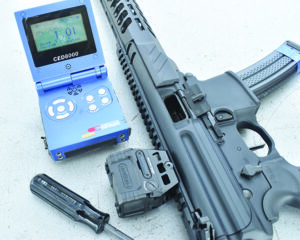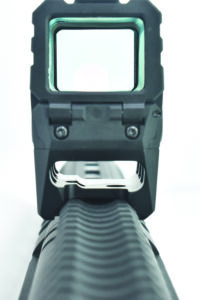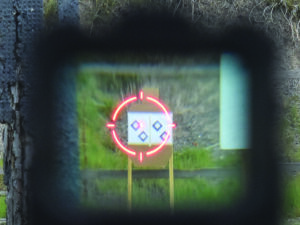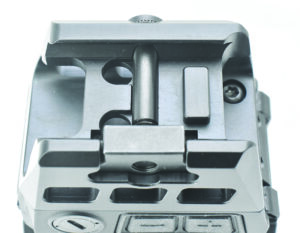We presented test results in the March 2020 issue about everyday-carry pistols with slide-mounted red-dot sights. As a result of that piece, Gun Tests readers sent in requests asking for more information about the new sights. When you ask, we try to deliver, so we hit the topic a second time in the November 2021 issue. Questions about still more additional optics followed immediately, though our responding readers seemed to be particularly interested in the Holosun brand. So get in, sit down, and hold on because we have new dope on four more sights for you, including the new Holosun AEMS (Brownells.com, 100-043-828WB, $399), Lucid Optics M7 (OpticsPlanet.com, $215), the Swampfox Justice model (Amazon.com, $235), and the Crimson Trace Rad Pro (MidwayUSA.com, $280).
We tried to keep the same testing format we used for the previous tests. Then we remembered the frustration we had with mounting systems for pistols, but still wanted to test the sights in a competition arena. We also wanted to see which products were flexible enough to be mounted on different platforms. So, we grabbed a SIG MPX 9mm that we use for USPSA Pistol Caliber Carbine (PCC) division and started shooting. We sighted in each red dot in turn, then shot them for feel and function at American Shooting Centers in west Houston. We shot the carbine/optic combo in practice for about a month and then finished everything off with a USPSA match. Observations were recorded at each step along the way. We still had a stash of Remington 115-grain 9mm ammo we were able to use for the tests.
Along with the factors we tested for in the past, we wondered if the “dot and a donut” reticle from the Holosun or the simple red-dot reticle like on the Swampfox would be faster. To see, we set up an “A Zone” plate (approximately 6 by 11 inches) at 9 yards and did one-shot drills from USPSA ready (port arms with the buttstock resting on the belt, safety engaged, and finger off the trigger). The differences were statistically insignificant — less than 0.02 seconds on average. Pick the reticle/body style you like and practice, practice, practice.

Our SOP has been to mount low- or zero-magnification optics well forward on the Picatinny rail. Just for giggles, we mounted various optics all over that mount — forward, middle, and rear. We decided, very subjectively, that we liked our existing practice and settled for mounting the red dots as far forward on the rail as possible while still keeping them actually attached to the receiver. We felt this method allowed us to focus on the reticle most quickly with both eyes open. It also seemed to allow us to point the carbine more naturally and helped us find the dot.
We understand that these manufacturers established their mount height with a different goal in mind than what we had in these tests. We were running the red dots on a competition-type pistol-caliber carbine in a United States Practical Shooting Association setting. We were looking for high-speed no-drag red dots that were easy to acquire and fast to use. The makers of our sights were generally trying to allow more defensive-minded users to co-witness their back-up iron sights through the lower parts of the dot windows in case the optic failed. Smart — and we don’t disagree with the concept at all. We just really liked the option to bring the sight to a lower level, which allowed us a more secure cheek weld. Lucid supplies its dot with multiple-height mounts, and Swampfox has a lower mount available on its website.
So with those fine points covered, we went to the range and shot these sights side by side.
Gun Tests Grade: A (OUR PICK)
$280
After our previous red-dot article, we received requests for info on additional optics, a number of which specifically mentioned the Holosun. We’ve seen the devices any number of times on the competition circuit, where they are known as something of a price brand. We wanted to know if they were just an inexpensive way to get a red dot or if there was a real sight there.
| Weight | 5.5 oz. |
| Length | 2.24 in. |
| Width | 1.46 in. |
| Dot Size | 2-moa with 65-moa circle |
| Height Above Rail | 2.23 in. |
| Sight Window | 0.82 x 1.05 in. |
| Mount Type | Picatinny rail clamp – 1 screw |
| Battery Type | CR2032 |
| Battery Change | Screw retained tray on right side |
| Estimated Battery Life | 20,000 to 50,000 hours |
| Control Location | Sides |
| Warranty | Limited lifetime |
| Telephone | (909) 594-2888 |
| Website | Holosun.com |
| Made In | China |

Being old Boy Scouts, we like to be prepared. Perhaps the most likely thing to happen to an electrical sight is a problem with or the exhaustion of the battery. To solve that, the Holosun AEMS has two power sources. A CR2032 battery loads into a tray on the right side that actually usually uses screws for retention — it is not just press to close. The screws also help seal the unit against moisture which, along with other features, earned the AEMS an IPX8 rating for waterproofing, just like the Lucid. A top-mounted solar cell charges an onboard battery that the unit uses when feasible. Some ambient light conditions and brightness settings require usage of the CR2032 battery, but the redundancy is nice to have. The LED emitter will go into “sleep” after 10 minutes of no movement and turns back on instantly when any motion is detected. The user even gets options on the sleep settings, with 10 minutes being the default with 1 hour, 12 hours, and disabled also being available choices.

Those two power supplies provide juice for three possible reticle styles. The default is a 65-moa circle surrounding a 2-moa dot. The user can also select circle only or dot only. The “dot and the donut” reticle uses the most power, but battery life is still estimated at around 20,000 hours. Using the dot only can increase battery life to around 50,000 hours. New technology in the solar cells makes them effective even in some lower-light conditions. The user has the option of eight daylight and four night-vision-compatible brightness settings. The operator can choose his settings manually or let the sight do it for him automatically. We used the auto function and had no trouble finding this dot even on a cloudless Texas afternoon.

More like the Lucid than the Crimson Trace or the Swampfox, the Holosun is totally enclosed. This sight is housed in a body made from solid 7075-T6 aluminum. Dust covers are provided fore and aft that can be left closed, lifted up, and secured or uninstalled via the removal of two screws. The Holosun also comes with an optional Picatinny rail (that was one of our requirements for this test). It installed easily and locked up solidly.
The Holosun AEMS (Advanced Enclosed Micro Sight) offers both red and green reticles. Science tells us that the human eye will see the green color spectrum more easily than the red. The green also requires more power, making it a bigger drain on the battery. This test group lives in southeast Texas where, much of the year, things are hot and green. We tend to choose red reticles just for the contrast with the foliage.
Our Team Said: The Holosun did not disappoint. The Pic rail adapter was one of our very few gripes. The frame lifted the AEMS body up a bit too high. This kept even the testers with “full” faces from easily achieving a good cheek weld. We were just a bit too low on the sight. That being said, the reticle was still very easy to find and use. We wish that Holosun included an additional, lower adapter.



























